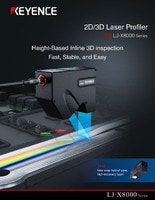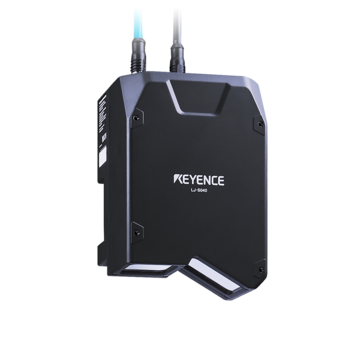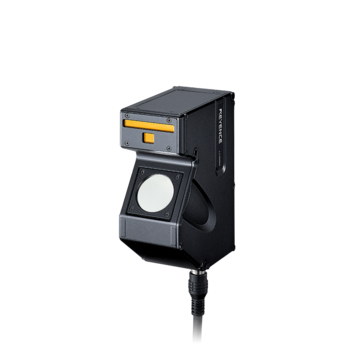Measurement Sensors
Dimension Measurement
Displacement Measurement
3D Laser Scanning: Benefits and Applications

Recent advancements in 3D laser scanners are revolutionizing industrial manufacturing. The technology offers unparalleled precision and efficiency in capturing and measuring complex shapes at high speed.
3D laser scanning is crucial to many industries, from construction to automotive to medical manufacturing. Each of these industries relies on laser scanning for quality assurance and quality control.
In this guide, we'll discuss what 3D laser scanning is, the technology’s benefits, and its advantages over traditional vision systems. Let's dive right in.
What is 3D Laser Scanning?
3D laser scanning is a non-destructive, non-contact measurement process that uses laser light to digitally capture the shape of physical objects. A scanner emits laser light that's reflected off an object's surface back to the sensor. The sensor then uses a complex algorithm to calculate how much light is displaced, and the resulting data points end up producing a 3D digital replica of the target object.
In other words, 3D laser scanning is a method of recording an object's exact size and shape into digital form as an accurate three-dimensional representation of said object. Accordingly, laser scanners are ideally suited to the measurement and 3D inspection of all types of surfaces and their geometries, which usually require a massive amount of data for accurate capture.
We’re here to provide you with more details.
Reach out today!

Key Benefits of Using 3D Laser Scanning
As previously stated, there are many benefits of 3D laser scanning for any operational process that relies on accurate measurement. Here's a more comprehensive breakdown:
Accuracy and Precision
Accuracy and precision are some of the most significant advantages of 3D laser scanning. Modern laser profilers are accurate down to the single-digit micron range, making them capable of 3D defect detection that would otherwise be impossible.
Speed and Efficiency
Most 3D laser scanners have very fast sampling rates and are able to capture thousands of profiles per second. This streamlines workflows associated with numerous operational processes and allows measurements to be performed inline.
Versatility
Thanks to their capabilities, 3D laser scanners can solve a variety of applications, ranging from reverse engineering and architectural design to forensic analysis and even virtual reality. They can effectively scan both small and large objects and easily perform captures in environments that are challenging for other measurement methods.
Non-Contact Measurement
The non-contact nature of this technology makes 3D laser scanners ideal for measuring and inspecting sensitive or delicate materials.
Discover more about this product.
Click here to book your demo.

3D Laser Snapshot Sensors for High-Speed Inspections
For manufacturing environments that demand flawless performance, 3D laser snapshot sensors offer a highly precise, non-contact approach to 3D inspection and measurements.
These sensors can be used to acquire detailed 3D images within milliseconds, thereby identifying potential defects. The result is that you can maintain stringent industry quality standards without slowing down production.
In comparison to traditional measurement methods such as vision systems, 3D snapshot sensors are much faster and more efficient when getting 3D data. This makes them an essential tool for industries that require quick and accurate quality control processes.
Integrating Automated Laser Snapshot Sensors for Advanced Defect Detection
When you automate with KEYENCE 3D snapshot sensors, you can easily streamline the inspection process, thereby reducing the risk of human error. Automated snapshot sensors give you highly accurate data, with stable Inspection and no need for troublesome adjustments.
It allows you to sense and detect surface irregularities, such as scratches or shape deviations, that may be invisible to the ordinary eye. Once integrated, it will continuously monitor your products to help you predict or avoid defects. Its importance in the automotive industry, for one, cannot be overemphasized. It provides accuracy while being cost-effective.
3D Laser Scanning vs. Conventional Vision Systems
There's little doubt that conventional vision systems have been and continue to be instrumental in industrial imaging applications, but 3D laser scanning offers some distinct advantages. For example, vision systems typically capture images in 2D and often cross-reference different images to produce a 3D image. 3D laser scanners actually capture depth information, thus offering a comprehensive three-dimensional capture of the target object's geometry.
This distinct capability is very important for applications that demand depth precision, such as quality control applications, manufacturing, and design processes. Of course, the choice of an adequate system ultimately comes down to application requirements.
Curious about our pricing?
Click here to find out more.

Inline/Nearline Measurements
In production and manufacturing, 3D laser scanners are usually integrated inline or near-line. Inline means the scanners are integrated into the production line itself, while near-line means they’re placed adjacent to the production line.
Inline 3D scanning solutions excel at providing real-time quality assurance and control by detecting defects—deviations from the desired, pre-set specifications—immediately as the parts and components are being produced. Near-line systems are slightly removed, which grants them the ability to handle batch samples for quality without interrupting the main production line.
Defect Detection
Defect detection remains one of the greatest benefits of 3D laser scanning solutions. Since they use light (instead of pictures), they can identify defects that would be invisible to the naked eye. This often includes small dents, warping, or incorrect dimensions of the manufactured part.
Early detection is actually quite important, as it helps mitigate numerous problems before they escalate into costly mistakes. For example, defect detection might indicate a problem with the production line, leading to a more preventive maintenance approach that can reduce the costs associated with unplanned downtime.
Early defect detection also reduces waste and the need for rework (and the necessary resources) while ensuring that only the high-quality, per-spec products make it to the next step in the production chain. This, in turn, ensures that the products meet the required standards, thus maintaining their quality and customer satisfaction.
Unlock the Power of 3D Laser Scanning with Real-Time Snapshot Sensors
At KEYENCE, you can discover the key benefits and diverse applications of LJ-S8000 Series sensors, from precise inline measurements to advanced defect detection. You can easily have real-time snapshot sensors that use laser tech to provide you with 3D images. 3D laser scanning has the power to capture, process, and analyze all products during the manufacturing process.
Why Choose KEYENCE?
KEYENCE is the world's leading provider of precision measurement technologies, which include laser displacement sensors, laser micrometers, 3D scanning solutions, and many other technologies used in manufacturing-specific applications across numerous industries.
If you're looking to enhance your operational processes with highly accurate and effective 3D scanning solutions, don't hesitate to contact KEYENCE and inquire about the possible integrations of our equipment with your existing production lines.
Contact us to learn more about how our advanced technology can help take your business to the next level.
Contact Us
FAQs
What are the 5 key benefits of using laser scanning?
The five benefits of laser scanning in manufacturing are accuracy and precision measurement, speed and efficiency, versatility, non-contact measurement, and 3D data visualization.
What is 3D laser scanning used for?
3D laser scanning captures the exact shape and dimensions of a physical object. This data can then be used to create 3D models, perform quality control inspections, complete reverse engineering, and many other applications.
What are the pros and cons of a 3D laser scanner?
The pros of using a 3D laser scanner include high accuracy, speed, and the ability to capture complex shapes and features. On the other hand, some cons include the initial cost of the equipment and potential limitations in scanning shiny or transparent surfaces.
We’re here to provide you with more details.
Reach out today!

Related Downloads
Related Products
Applications
Dimension Measurement
- Thickness and Width Measurement
- Step Height Measurement
- Inner and Outer Diameter Measurement
- Measuring Angles
- Meandering/Edge Measurement
Displacement Measurement
- Positioning and Stroke Length Measurement
- Vibration and Runout Measurement
- Deflection Measurement
- Measuring Eccentricity





